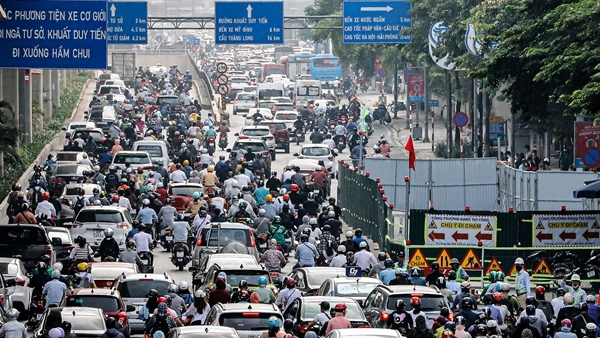Ha Noi seeks US$53 billion to ease congestion
VGP - Ha Noi has finalized its 2025–2030 Traffic Congestion Reduction Plan, estimating a required investment of around US$53 billion. The bulk of this spending will go toward developing a modern urban rail system—seen as crucial to addressing the capital’s chronic traffic jams.

The city is undertaking an ambitious overhaul of its transport network, with 15 urban metro lines planned. These projects are technically demanding and financially heavy, yet viewed as indispensable to reducing congestion, cutting emissions, and curbing reliance on private vehicles.
Transport expert Le Trung Hieu cautioned that worsening congestion threatens Ha Noi's sustainability and livability, stressing that metro development is "the most strategic solution to improve Hanoi's traffic."
According to Nguyen Cao Minh, Chairman of the Ha Noi Urban Railway Management Board, strengthened public transport is expected to meet 50–55 percent of travel demand in central districts by 2030, rising to 65–70 percent afterward—a goal unattainable without a comprehensive metro network.
When operational, the system could serve 3.2 million passengers daily, accounting for 35–40 percent of public transport demand in core areas and about 20 percent in suburban zones.
Ha Noi also intends to promote transit-oriented development (TOD), concentrating urban growth around metro corridors. "A metro system doesn't just mitigate congestion and pollution—it fuels economic expansion and enhances Hanoi's global competitiveness," Minh emphasized.
This direction is consistent with national priorities laid out in the 13th National Party Congress Resolution, Politburo Resolution No. 30-NQ/TW (2022), and Conclusion No. 49-KL/TW (2023)—all positioning metro infrastructure as a top-strategic priority.
Further political backing has come from the National Assembly and Government, which endorsed the Comprehensive Urban Railway Investment Plan and a pilot mechanism granting Ha Noi and Ho Chi Minh City greater authority to fast-track metro projects.
Minh noted that the city's vision now exceeds earlier ambitions: "The original blueprint included 10 lines, but we have revised the plan to 15 routes integrated with TOD redevelopment."
The full network, to be implemented through 2045, is projected to require VND 1.39 quadrillion (US$55.44 billion) in investment.
To meet the vast funding needs, Conclusion No. 49-KL/TW directs mobilizing all available resources while prioritizing rail development in the national infrastructure strategy.
Domestic capital will remain the foundation, with the state budget playing a key role and external financing providing strategic leverage.
The city will review all public investment sources, including budget allocations, bonds, ODA loans and other lawful channels, to fund this long-term metro program.
Ha Noi's metro expansion follows a "one strategy, three phases" roadmap based on five principles: align investment with funding capacity, maximize efficiency, prioritize central routes already studied in detail, connect key transport hubs such as airports and main stations, and ensure technological consistency and effective execution.
Phase 1 (to 2030) will complete 96.8 km of metro lines (Nos. 2, 3.1 and 5) and prepare 301 km for construction, with an investment of VND406 trillion (US$16.21 billion). The system will operate about 680 metro cars, serving 2.2–2.6 million daily trips, or 7–8 percent of all public transport.
Phase 2 (2030–2035) will add 301 km with 2,110 metro cars at an estimated cost of VND526 trillion (US$20.97 billion). By then, metro services are expected to handle 9.7–11.8 million trips daily, accounting for 35–40 percent of urban passenger transport.
Phase 3 (2035–2045) will construct 196.2 km more, costing VND458 trillion (US$18.27 billion) and deploying 1,375 metro cars.
By 2045, Ha Noi plans to complete over 600 km of tracks and operate 15 lines with 4,165 metro cars, an ambitious yet determined vision for sustainable urban mobility.

